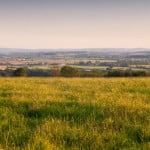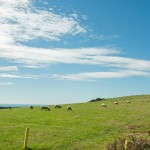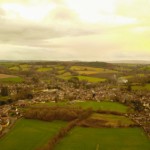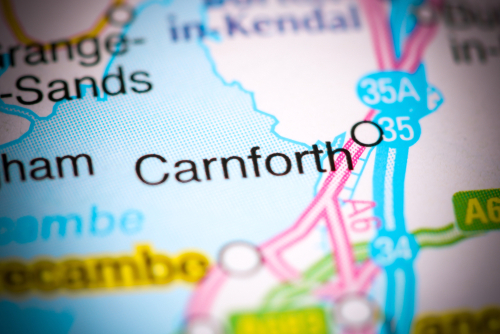
A quick guide to Carnforth
Carnforth is a small town and civil parish, situated in the north of Lancashire, northwest England. It’s located 8 miles (13 km) north of Lancaster, and 22 miles (35 km) south of Kendal, at the northeast end of Morecambe Bay. The A6 trunk road, the River Keer and the Lancaster Canal, all pass through the town. At the 2011 UK Census, the town’s population was recorded as 5,560.
A Fleeting History
The earliest settlement of the Carnforth area dates back to around Anglo-Saxon times when it is thought a small community just to the northeast of today’s town was present. The name ‘Carnforth’ is thought to be derived from the settlement’s location at a ford on the River Keer. Over time, the designation of ‘Keer-ford’ was corrupted to the modern-day name of ‘Carnforth’. An alternative theory is that the name derives from the Anglo-Saxon term ‘Chreneforde’, which means an expanse of water frequented by cranes.
During medieval times, Carnforth was a small farming hamlet, part of the parish of Warton, which at the time was the more developed settlement. During the 17th century, being at the conjuncture of three roads, the town developed both as a convenient stopover for travellers. Several inns soon sprang up and a small market developed. However, much of the history of Carnforth starts with the coming of the Industrial Revolution.
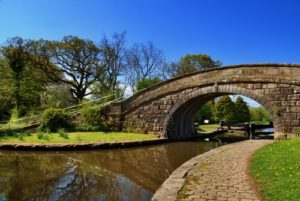
Carnforth lies near the Lancaster Canal
At the end of the 18th century, the Lancaster to Kendal canal was constructed, which saw it opened in 1797. The canal passed through Carnforth and was extensively used to export limestone southwards, while coal from the Lancashire coalfields was transport North. The vast deposits of limestone located around Carnforth made it an ideal location for ironworks since the mineral was a key component in the smelting process. In 1846, the Carnforth Ironworks Company was founded, just as the Earl of Dudley Ironworks in Worcestershire experienced a major contraction. Some of the redundant Midlands workers moved North to take up the new jobs on offer in Carnforth. They were housed in the newly constructed company village of Dudley (now Millhead).
It was also in 1846, Carnforth Railway Station was opened by the Lancaster and Carlisle Railway Company, originally being just a single platform. In 1856, it became a juncture, following the connection of the Furness and Midland Railway lines. In 1857, a small station and engine shed were constructed. At the start of the 1880s, the station was totally rebuilt at a cost of £40,000. The growth of Carnforth as a rail transport hub continued through to the early 1950s. And, at its height, Carnforth was seeing more than 100 passenger and freight trains pass through the station.
In 1864, the Carnforth Haematite Company took over the town’s Ironworks. Production at the works was greatly ramped up as iron ore was brought in by rail from the Furness Peninsula. In 1872, the plant switched to steel production adopting the new Bessemer process. However, starting in 1889, production at the plant went into a slow, steady, prolonged decline, as competition grew.
Construction of the A6 principal road at the end of the 19th century fundamentally changed the character of the town. The established town centre shifted from the area around the Shovel Inn to lower Market Street. Another major change for the town occurred in 1929 when the steelworks finally folded after 40 years of decline. The site was taken over by the War Department and reopened as an ordnance depot, which remained in operation until its closure in the 1960s.
In the early 20th century, the town saw the opening of an auction mart and a cinema. Between the 1920s and 1980s, Morphy’s Mill in Oxford Street was a major manufacturer it the town. It mostly employed women and produced womenswear.
The Modern Era
A growing population throughout the 20th century led to a significant educational advance for Carnforth. The town which had elementary and primary schools since the 19th century finally got a secondary school in 1959. This meant pupils, aged 11 to 15 years, no longer needed to travel to Lancaster or Morecambe for schooling.
The 1960s radical reorganisation of the railways by Dr Beeching led to a gradual rundown of the Carnforth station. The mainline platforms were closed down, and then in 1970 physically removed, to make way for the electrification of the West Coast Main Line. Carnforth was then reduced to a branch station and the buildings gradually fell into disrepair. The railway station is nowadays served by trains from Lancaster to Barrow and Leeds.
Compensating for its loss of the railway, Carnforth saw the construction of the M6 motorway in the 1960s, which helped to stimulate the local quarrying industry. One of the country’s most strategic motorways, it passes just to the east of town, being linked by the A601(M). The link has proved vital in helping to retain employment in the town, particularly in the light industry and transport sectors.
In the 1980s, the auction mart closed, with the site being redeveloped as a retail outlet area, which now caters to the town’s growing population and increasing tourist numbers. Due to its ideal location between Morecambe Bay and the Yorkshire Dales, the town has in recent times, become a popular base for walkers and cyclists exploring the area.
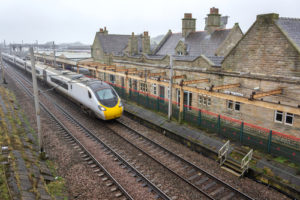
Carnforth lost its mainline status in the late 1960s under the Beeching cuts
Getting there!
By Road
The easiest way to get to Carnforth by road is via the M6. Turn off the M6 at Junction 35, then take the mile-long A601(M) which leads to the A6. Turn left onto the A6, Carnforth is less than a mile.
By Train
There a few options for getting to Carnforth by train. The quickest way to Carnforth by train is via the West Coast Main Line, changing at Preston. Carnforth railway also lies on the Furness Line, which runs from Barrow-in-Furness to Lancaster and onwards to Manchester Airport. Carnforth is also a stop on a branch line from the Carlisle – Leeds line.
By Bus
If you aim to get to Carnforth by bus, then National Express run a coach service to Lancaster. From Lancaster, the regular local service bus takes about 30 minutes.
By Air
Manchester Airport is the nearest airport to Carnforth and about a 1 hr 10 minutes journey time by car (See above – By Road).
Did you know?
Carnforth railway station was used as a location for the shooting of David Lean’s classic film Brief Encounter, starring Celia Johnson and Trevor Howard. The railway station was refurbished in the early 2000s, including a new refreshments area, which has been fitted out to match the set as it was for the memorable 1945 film. The eatery is run by the Carnforth Station Trust.
Famous People
High profile Conservative Party politician Cecil Parkinson was born in Carnforth on 1 September 1931. He was first elected as an MP for Enfield West in 1970. He went on to serve in several ministerial positions, between 1981 and 1990, under the tenure of then PM Maggie Thatcher. He resigned his Cabinet position on 28th November 1990, the same day Margret Thatcher lost the leadership of the Conservative Party. He became Baron Parkinson of Carnforth in 1992 and died on 22 January 2016.
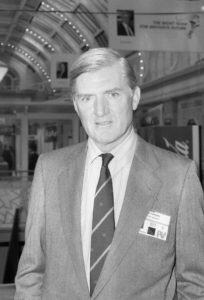
Cecil Parkinson in the 1980s
Sport
Carnforth RUFC
Carnforth RUFC plays in Division 2 of the Lancashire County RU League. They play their home games at Kellet Road.
Carnforth Rangers
Carnforth Rangers play in the Premier Division of the North Lancashire and District Football League, the 14th tier of English Football
Things to see and do!
- Carnforth Station & Visitors Centre – is the main attraction in Carnforth. The award-winning site is a popular tourist attraction due to its links with the 1945 classic film, Brief Encounter.
- Warton Crag – the highest point of the Arnside & Silverdale AONB, is only about 1.5 miles from Carnforth. The limestone grassland, scrub and woodland area is easily accessible by public transport. The site is recognised as nationally important for the rare butterflies, moths and plants that can be found. Peregrine Falcons regularly nest in the area.
- Leighton Hall – is a historic Gothic mansion with extensive gardens which is just 2.5 miles away from Carnforth. The beautifully furnished house is still the lived-in home of the Gillow family. There are guided tours offered on most days. There’s also several nature trails around the grounds and a gift shop.
- Morecambe Bay – you can access the Bay 3 miles southwest of Carnforth at Hest Bank but Morecambe itself is only 2 or 3 miles further on. The Bay’s recognised as one of the best places in the UK for adrenalin-fuelled activities such as sailing, powered paragliding, parachuting, windsurfing, mountain biking, horseriding, and kitesurfing. The ‘Way of the Roses’, a 170-mile cycle route that goes to Bridlington Bay on the East coast, starts in Morecambe, as well as the ‘Lancashire Coastal Way’ long-distance walk passing through the area.
- Lancaster Canal – dates back to the late 18th century. The Preston to Tewitfield (less than 3 miles from Carnforth) 41-mile section is currently the only length that is navigatable.
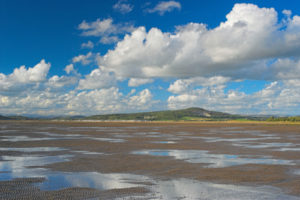
Distant view of Warton Crag from Morecambe Bay
Where to stay?
The limited amount of accommodation that is available in and around Carnforth, generally ranges from £70 to £100, for 2 adults sharing. If you’re looking for something cheaper then you can probably find that in Morecambe about 5 miles away. Lancaster, Grange-over-Sands and Arnside offer good close buy alternatives to actually staying in Carnforth, but expect to pay a little more.
The Carnforth Quiz
